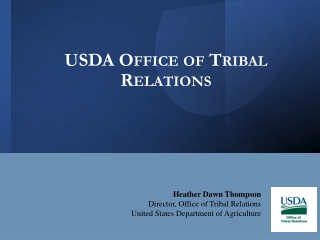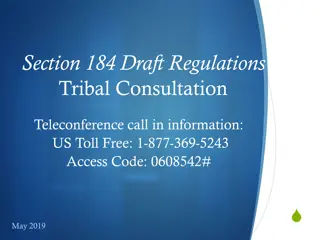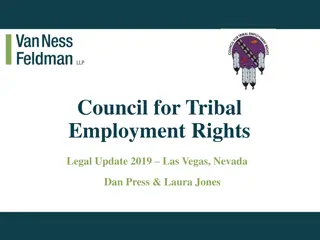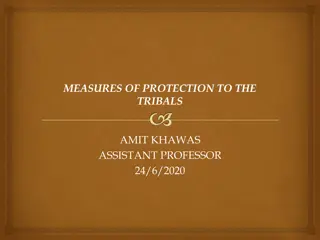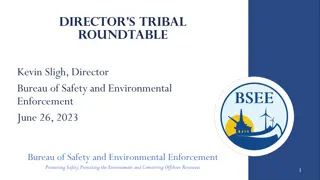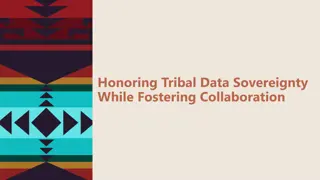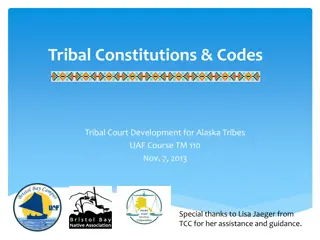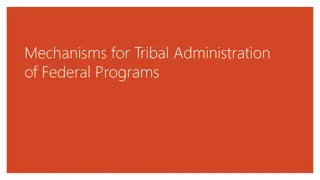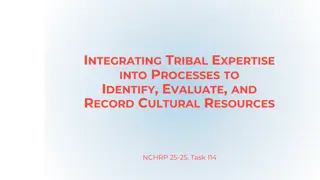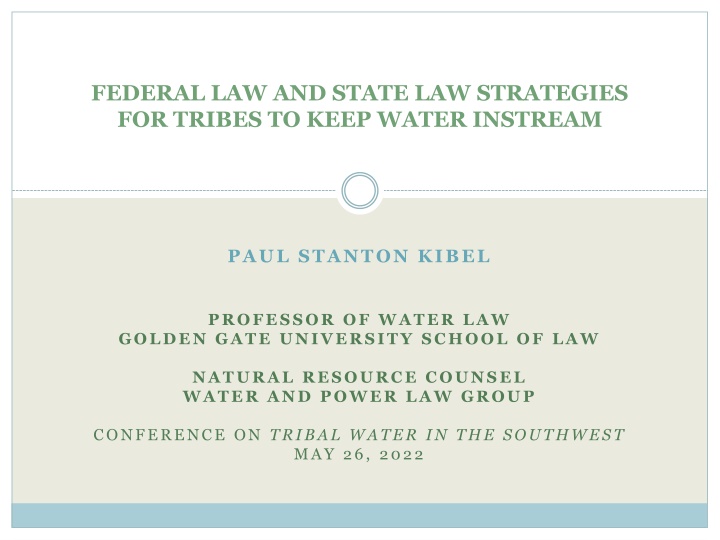
Strategies for Tribes to Protect Instream Water Rights
Explore federal and state law strategies for tribes to maintain instream water rights, distinguishing them from out-of-stream diversions. Learn about the global context, tribal instream waters like fishery and sacred waters, and legal challenges faced by tribes in asserting instream rights.
Download Presentation

Please find below an Image/Link to download the presentation.
The content on the website is provided AS IS for your information and personal use only. It may not be sold, licensed, or shared on other websites without obtaining consent from the author. If you encounter any issues during the download, it is possible that the publisher has removed the file from their server.
You are allowed to download the files provided on this website for personal or commercial use, subject to the condition that they are used lawfully. All files are the property of their respective owners.
The content on the website is provided AS IS for your information and personal use only. It may not be sold, licensed, or shared on other websites without obtaining consent from the author.
E N D
Presentation Transcript
FEDERAL LAW AND STATE LAW STRATEGIES FOR TRIBES TO KEEP WATER INSTREAM PAUL STANTON KIBEL PROFESSOR OF WATER LAW GOLDEN GATE UNIVERSITY SCHOOL OF LAW NATURAL RESOURCE COUNSEL WATER AND POWER LAW GROUP CONFERENCE ON TRIBAL WATER IN THE SOUTHWEST MAY 26, 2022
OUTLINE AND OVERVIEW OF PRESENTATION I. INTRODUCTION: DISTINGUISHING TRIBAL INSTREAM RIGHTS FROM TRIBAL RIGHTS TO OUT-OF-STREAM DIVERSIONS II. GLOBAL CONTEXT FOR TRIBAL INSTREAM WATER RIGHTS IN THE SOUTHWEST III. TRIBAL INSTREAM WATERS: FISHERY WATERS AND SACRED WATERS IV. FEDERAL LAW STRATEGIES FOR TRIBES TO KEEP WATER INSTREAM V. STATE LAW STRATEGIES FOR TRIBES TO KEEP WATER INSTREAM: EXAMPLES FROM CALIFORNIA VI. CONCLUSION: RETURN TO THE GLOBAL CONTEXT
INTRODUCTION: DISTINIGUISHING TRIBAL INSTREAM RIGHTS FROM TRIBAL RIGHTS TO OUT-OF-STREAM DIVERSION The Winters doctrine, the dominant legal framework for the recognition of tribal water rights in the United States, is a doctrine that was initially developed in connection with tribal rights to out-of-stream diversions. Similarly, the PIA (Practicable Irrigable Acreage) standard is for quantifying out-of-stream diversions. Yet there are circumstances where a tribe s interest is to keep water flowing instream rather than diverting the water out-of- stream for consumptive uses, and the Winters doctrine has often proven a difficult legal basis for tribes to assert such instream rights. 2
II. GLOBAL CONTEXT FOR TRIBAL INSTREAM WATER RIGHTS IN THE AMERICAN SOUTHWEST Instream Values Also Grounded in Christian and Hindu Religious Traditions (Protection of Holy Wells in Ireland and Protection of Ganges River in India) Recommended reading: Celeste Ray, The Origins of Ireland s Holy Wells (2014) Article 31 of United Nations Declaration on the Rights of Indigenous Peoples (provides for the right of indigenous peoples to maintain and strengthen their distinct spiritual relationship with traditionally owned or otherwise occupied or used lands, territories, waters, costal areas and other resources ). The United States is a signatory to the United Nations Declaration on the Rights of Indigenous Rights.
III. TRIBAL INSTREAM WATERS: FISHERY WATERS AND SACRED WATERS Tribal fishery waters most often relate to salmon-bearing rivers and streams in Northern California, Oregon, Washington and Idaho (and Pacific Northwest Tribes with deep spiritual and cultural relationships to salmon). Examples would be Tribes (such as the Nez Perce in Idaho and Karuk and Yurok in California) whose reservations and/or traditional fishing sites are along waterways in the Columbia River- Snake River Basin or the Klamath River-Trinity River Basin. Tribal sacred waters relate to water with deep connections to tribal ceremonial, religious and spiritual practices that may not be related to fisheries. Examples in the American southwest include: the Taos Pueblo Indians in New Mexico (and connection to the Buffalo Pasture Wetland); the Hualapai Tribe in Nevada (connection to water flowing from the base of Spirit Mountain near the Grand Canyon); and Apache Tribes in Arizona (connection to Montezuma s Well, spring located in central Arizona). Recommended reading: Michelle Bryan, Valuing Sacred Tribal Waters Within Prior Appropriation, 57 Natural Resource Journal 1 (2017)
IV. FEDERAL LAW STRATEGIES FOR TRIBES TO KEEP WATER INSTREAM TRIBAL FISHERY WATERS - Winters Doctrine/Stevens Treaties (some courts have held tribal rights to fish give rise to tribal rights to instream flows to maintain fish - See Snake River Basin Adjudication) - Federal Endangered Species Act (instream flows to maintain/restore endangered fish) - Federal Power Act (FERC hydropower relicensing; releases downstream of dam) Recommended reading: Katheryn Bilodeau, The Elusive Implied Right to Water for Fish: Do Off-Reservation Instream Water Rights Exist to Support Indian Treaty Fishing Rights?, 48 Idaho Law Review 515 (2012). TRIBAL SACRED WATERS - National Environmental Policy Act (NEPA)(cultural impacts included within definition of environmental impacts; duty to feasibly mitigate and consider alternatives) - 2012 American Indian Religious Freedom Act (AIRFA) (right to practice traditional religions including access to sites . . . and the freedom to worship through ceremonial and traditional rites ) - Executive Order 13007 (1996) (directs federal agencies to accommodate tribal access to and ceremonial use of sacred sites ) - Executive Order 13175 (2000)(calls for federal agencies to meaningfully consult with tribal officials on federal actions/policies that have tribal implications )
V. STATE LAW STRATEGIES FOR TRIBES TO KEEP WATER INSTREAM: EXAMPLES FROM CALIFORNINA TRIBAL FISHERY WATERS - California Endangered Species Act (CESA)(endangered fisheries protection, litigation regarding application of CESA to Bureau of Reclamation s Central Valley Project) - California Public Trust Law and Reasonable Use Law (National Audubon decision by California Supreme Court held public trust resources/uses must be fully protected whenever feasible; Per provisions of California Constitution and California Water Code wasteful/unreasonable uses of water and methods of water diversion are unlawful) - Beneficial Use and Waters/Instream Flow that Supports Fisheries (Pursuant to California water law, protection is afforded by the State Water Board and California courts to recognized beneficial uses of water; water to support fisheries/fish spawning is expressly recognized as a beneficial use ) TRIBAL SACRED WATERS - California Environmental Quality Act (CEQA)(similar to NEPA, requires state and local agencies to assess and feasibly mitigate adverse project impacts on cultural resources) - Beneficial Use and State Water Board Resolution 2016-0011 (water for tribal and cultural practices now recognized as beneficial use under California water law)
VI. CONCLUSION: RETURN TO GLOBAL CONTEXT As noted at beginning of presentation, the concept of legal protection for sacred waters is not something unique to Native Americans in the United States or to indigenous cultures in general. The concept of protection for sacred waters exists within the Christian religion (e.g. holy springs in Ireland) and the Hindu religion (e.g. Ganges River in India). Similar examples of sacred waters can be found in Buddhist, Jewish and Muslim religious traditions. 6 As a signatory to the 2007 United Nations Declaration on the Rights of Indigenous Peoples, the United States has signaled its international support for the rights of indigenous people to have access to and maintain their spiritual relationship with waters they have traditionally used. The enhanced recognition of and protection of sacred tribal waters under domestic federal and state law in the United States is consistent with these international obligations and principles.
FEDERAL LAW AND STATE LAW STRATEGIES FOR TRIBES TO KEEP WATER INSTREAM PAUL STANTON KIBEL PROFESSOR OF WATER LAW GOLDEN GATE UNIVERSITY SCHOOL OF LAW NATUAL RESOURCE COUNSEL WATER AND POWER LAW GROUP Conference on Tribal Water in the Southwest May 26, 2022

